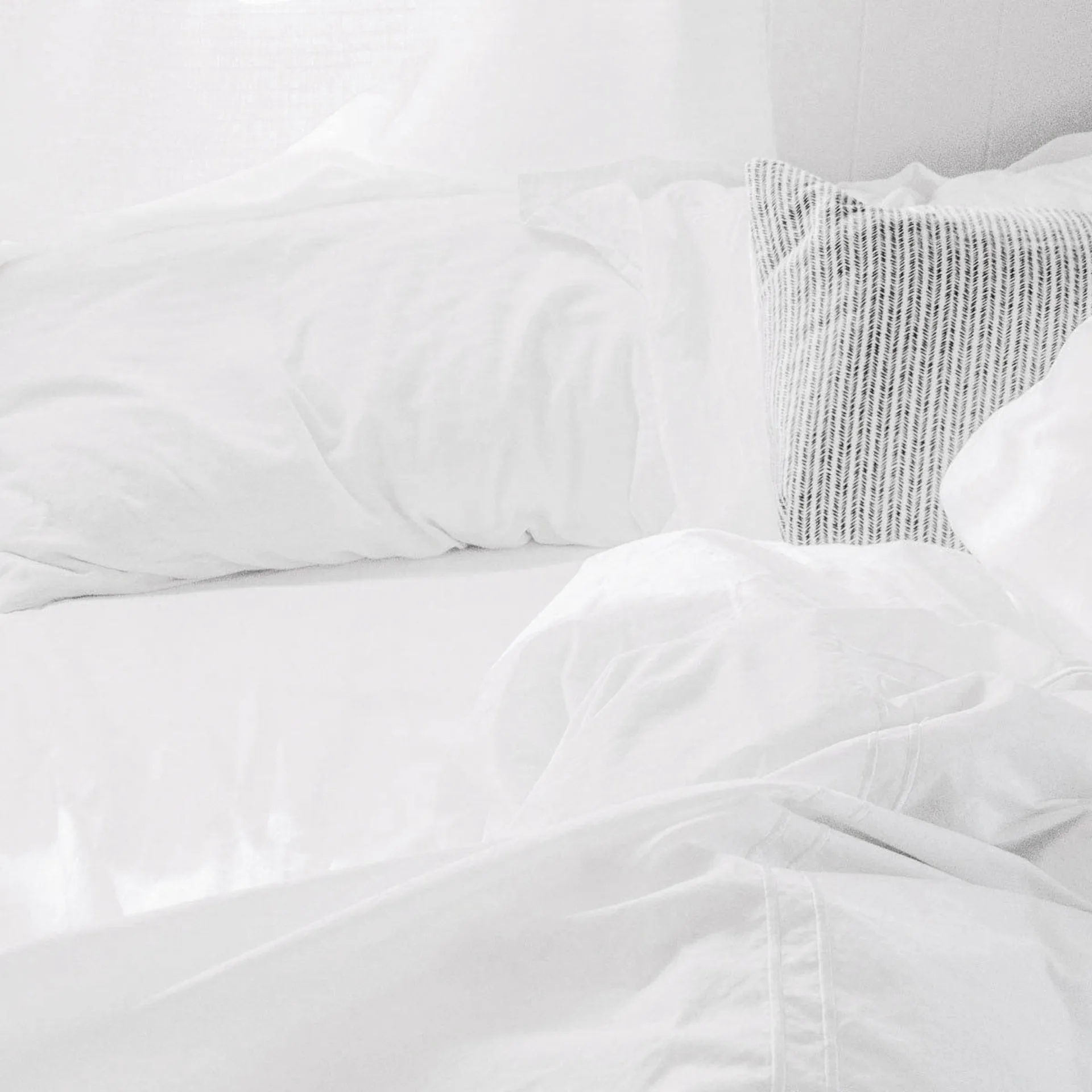Your 25 Grams of Fiber Meal Plan Just Got a Major Upgrade (And Your Gut Will Thank You)

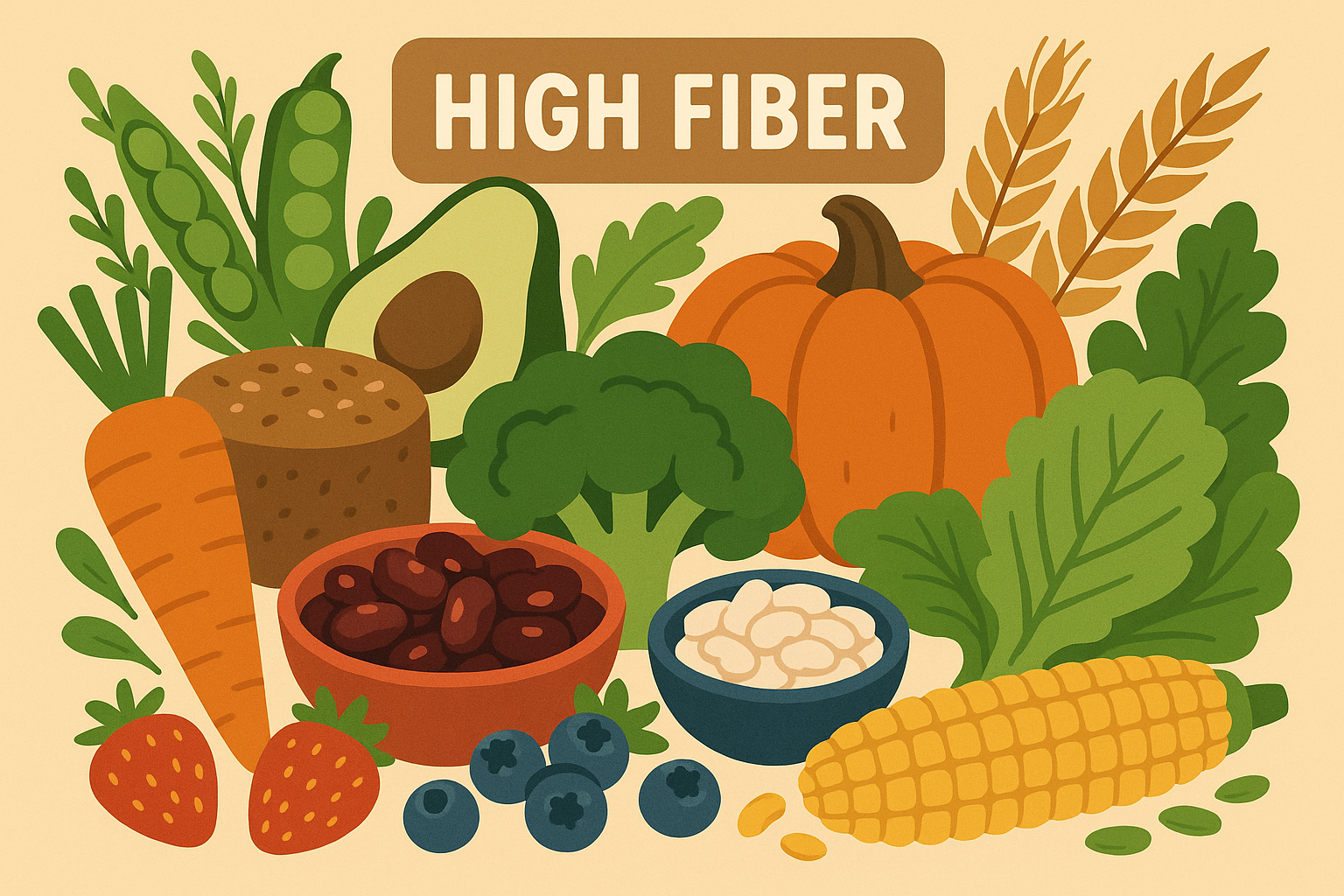
Let’s be honest – most of us know we should eat more fiber, but between the bloating, the gas, and trying to figure out which foods actually count, it feels like more trouble than it’s worth. I get it. Most Americans only get about 15 grams of fiber daily, falling well short of the recommended 25-30 grams according to UCSF Health.
I used to think fiber was just about staying regular too, until I discovered it’s actually the secret to having steady energy all day and feeling genuinely satisfied after meals. What I learned completely changed how I approach my daily nutrition – and it’s way simpler than you might think.
Understanding the science behind why fiber is so good for your health goes far beyond simple digestive benefits and reveals how it can actually stabilize your energy and mood.
Table of Contents
- How Your Gut Bacteria Actually Work
- Getting the Most from Your Fiber
- How Fiber Changes Your Body
- Making Fiber Work in Real Life
- The Best High-Fiber Foods and When to Eat Them
- Final Thoughts
TL;DR
- Your gut bacteria literally “pay” you with feel-good compounds when you feed them the right fiber types – making variety and timing way more important than just hitting 25 grams
- The order you eat different fibers throughout the day can make you feel dramatically better compared to just randomly adding fiber to meals
- Strategic fiber intake can fundamentally change how your body processes energy and can even affect how your genes work
- Start slow to avoid digestive drama – your system needs 2-4 weeks to build up the enzymes that digest fiber properly
- The 5-10-10 approach (5g breakfast, 10g lunch, 10g dinner) keeps you comfortable while maintaining steady energy all day
How Your Gut Bacteria Actually Work
Here’s the thing – most people think about fiber as just roughage for regularity, but I discovered it’s actually the foundation of this incredible partnership happening in your gut right now. Your gut bacteria and the fiber you eat create this complex system that influences everything from your mood to your immune system to how well you sleep at night.
Think of your gut bacteria like tiny workers in a factory. When you feed them the right types of fiber, they produce compounds that literally make you feel better – better mood, better energy, better everything. But if you just randomly throw fiber at them, it’s like giving your workers the wrong tools.
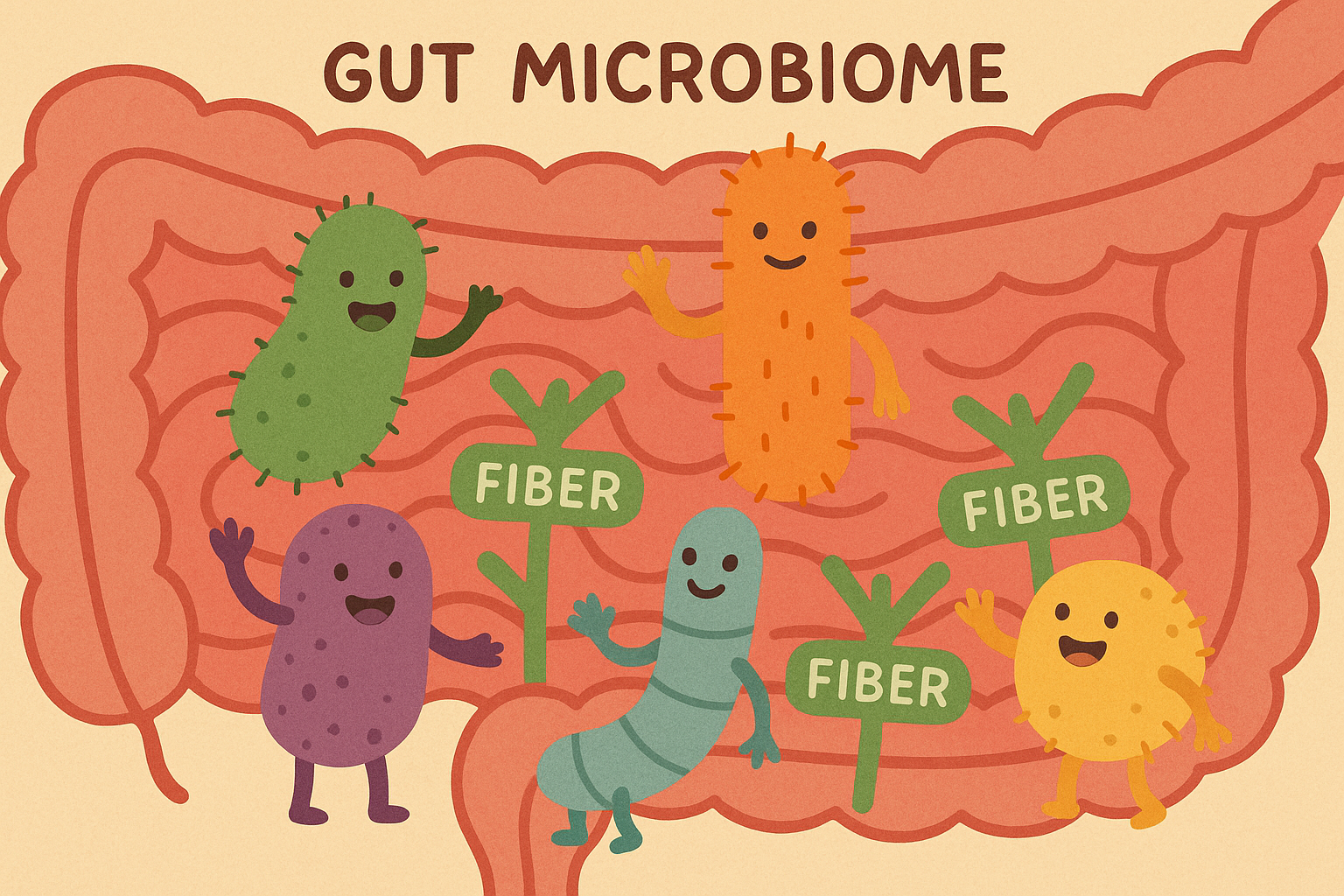
The bacteria living in your digestive tract don’t just break down food – they manufacture compounds that directly influence your brain chemistry, hormone production, and immune responses. High-fiber foods serve as the raw materials for this internal pharmacy that’s working 24/7 to keep you healthy.
The Gut Bacteria Payment System
I learned that gut bacteria essentially operate on a payment system – they produce beneficial compounds in exchange for the right types of fiber. This is why your daily fiber intake can become truly transformative instead of just functional. Understanding this system helps you choose fibers that give you the biggest return on your investment.
For those looking to optimize their digestive health beyond fiber intake, exploring simple ways to beat bloat and improve digestion provides strategies that work perfectly alongside high-fiber nutrition.
What Your Bacteria Actually Make
Different fiber types help your gut bacteria produce different compounds – and each one does something specific for your health. Some support brain function, others help your liver work better, and some aid in cellular repair. The key is eating a variety of fiber sources so you’re producing all of them in good amounts.
Here’s the cool part – when your gut bacteria break down fiber, they create these compounds that are basically like natural mood boosters and energy stabilizers. Different fibers make different compounds, which is why eating a variety matters more than just hitting your number with one type of food.
Want to know which foods make which compounds? Here are the ones I focus on:
For Brain Function and Gut Health:
- Cooled potatoes, green bananas, cooked and cooled rice
For Cellular Repair:
- Jerusalem artichokes, garlic, onions
For Cholesterol and Liver Health:
- Oats, barley, mushrooms
For Blood Sugar Control:
- Apples, citrus fruits, berries
These fiber-rich compounds work together in ways that amplify each other’s effects. When you eat a variety of fiber types throughout the day, you’re essentially conducting an orchestra of beneficial bacterial activity.
How Your Bacterial Neighborhood Changes
Your fiber choices create predictable shifts in which bacteria thrive in your gut, and certain beneficial strains take over based on what you consistently feed them. These population changes affect everything from mood stability to skin health. I’ve noticed that eating diverse fiber sources prevents any single type of bacteria from taking over completely.
The fascinating part is how quickly these changes happen. Within just 24-48 hours of changing what you eat, you can see significant shifts in which bacteria are thriving.
The Bacterial Sharing Network
Here’s where it gets really cool – your gut bacteria actually share nutrients with each other. One species’ waste becomes another’s fuel, creating these cascading health benefits that multiply your fiber investment. The key is providing diverse fiber types that support these complex bacterial relationships.
Why Timing Your Fiber Matters
Your body’s ability to process fiber changes dramatically throughout the day, making timing just as important as the amount you eat. I discovered that understanding these natural rhythms can make your 25-gram target way more effective without actually eating more fiber.
Morning Fiber Sets Your Day
Starting your day with fiber activates specific digestive enzymes and gets your beneficial bacteria working, which sets your metabolic tone for the entire day. I’ve found that having about 5 grams of mixed fiber sources for breakfast creates sustained energy and appetite control that lasts well into the afternoon.
Sarah, a busy marketing executive, completely transformed her energy levels by starting each day with steel-cut oats (4g fiber) topped with chia seeds (5g fiber) and berries (2g fiber). This 11-gram fiber breakfast eliminated her mid-morning energy crashes and reduced her afternoon sugar cravings by 80% within just two weeks.
Evening Fiber for Overnight Repair
Eating fiber at night triggers different responses in your body that focus on cellular repair and toxin elimination while you sleep. Having your biggest fiber meal in the evening (around 10 grams) supports overnight detoxification and reduces morning inflammation.
I personally notice better sleep quality and more consistent morning energy when I eat my highest fiber meal at dinner. The timing makes a measurable difference in how I feel the next day.
How Fiber Affects Your Hormones
High-fiber foods create complex hormonal responses that go way beyond just making you feel full. These changes influence stress hormones, sleep quality, and even reproductive health in ways most people never think about when planning their daily fiber intake.
Natural Appetite Control
Specific fiber combinations naturally boost production of GLP-1, a hormone that regulates appetite and blood sugar in ways that rival some medications. I’ve discovered that combining soluble and insoluble fibers in the same meal maximizes this natural response.
According to recent research, an estimated 95 percent of American adults and children do not consume their recommended amounts of fiber, making this natural appetite regulation particularly important for most people.
The hormonal benefits go beyond just appetite control. Regular high-fiber food consumption influences cortisol patterns, insulin sensitivity, and even thyroid function in ways that build up over time.
Getting the Most from Your Fiber
The order and combination of different fiber types throughout your day creates effects that can triple the health benefits of your 25-gram intake. Random fiber consumption leaves massive benefits on the table, while strategic timing optimizes nutrient absorption, toxin elimination, and gut barrier strengthening.
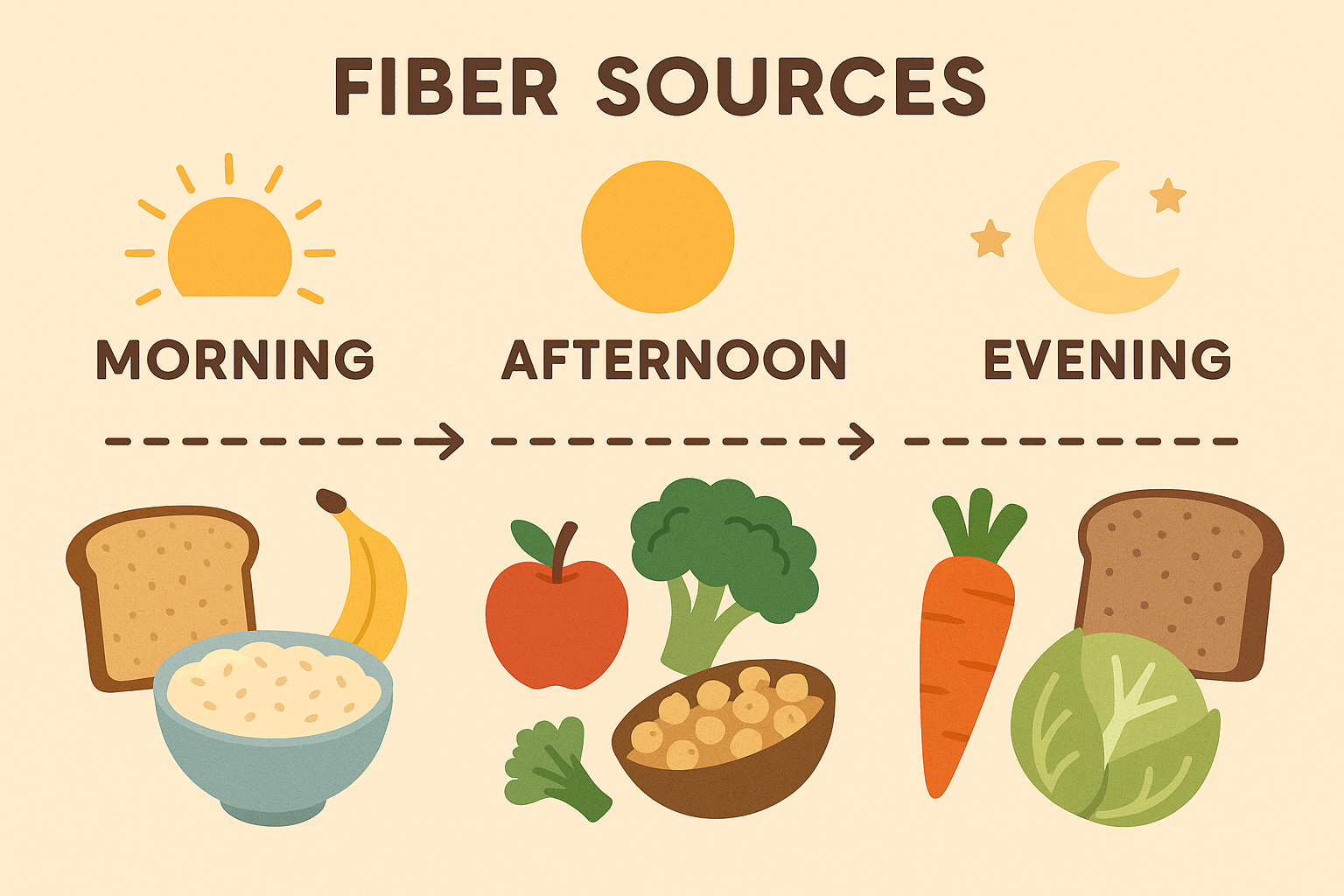
I used to think fiber was fiber – boy, was I wrong. The timing and combination of different types creates entirely different outcomes in your body. High-fiber foods eaten in strategic sequences can dramatically amplify their individual benefits.
How Different Fibers Work Together
Strategic pairing and timing of soluble versus insoluble fibers creates optimal conditions for sustained energy and prolonged satiety. Understanding how these two fiber types work together is crucial for making your daily 25-gram target actually effective.
The Timing of Fiber Gels
Different soluble fibers form protective gels at different speeds, letting you control sustained energy release throughout your day. Pectin from apples forms gels quickly, while beta-glucan from oats creates longer-lasting fullness. Timing these strategically prevents energy crashes and keeps blood sugar stable.
When I eat an apple with almond butter mid-morning, the quick gel formation from pectin provides immediate satisfaction, while the slower-acting fiber from almonds keeps me full through lunch. This timing strategy eliminated my tendency to overeat at meals.
Dealing with Anti-Nutrients
High-fiber foods often contain compounds that can block nutrient absorption, but simple preparation and combination techniques neutralize these effects while amplifying fiber benefits. I’ve discovered that basic preparation methods can reduce these blocking compounds by up to 90% while increasing mineral absorption.
Simple Soaking and Sprouting
Soaking, sprouting, and fermenting high-fiber foods dramatically reduces compounds that block minerals while maintaining all the digestive benefits. I soak my beans and grains overnight, which improves mineral absorption, reduces cooking time, and makes them way easier to digest.
This preparation step seemed like a pain at first, but the improved digestion and energy levels made it worth the minimal extra effort. Plus, soaked beans cook in half the time.
Smart Food Pairing
Pairing high-oxalate fiber sources (like spinach) with specific minerals and probiotics prevents kidney stone formation while maintaining digestive benefits. Adding calcium-rich foods or magnesium supplements when eating spinach or almonds creates protective buffering effects.
Targeting Specific Bacteria
Moving beyond generic “prebiotic” labels to understand which specific fiber compounds feed the beneficial bacteria strains linked to your individual health goals. This targeted approach ensures your 25 grams of fiber are working specifically for what you want to achieve.
Feeding the Right Bacteria
Different fiber types selectively nourish specific bacterial strains – some fibers feed Bifidobacterium while resistant starch preferentially supports Akkermansia muciniphila. I’ve learned to match my fiber choices with the bacterial strains I want to promote based on my health goals.
Combining Probiotics with Their Favorite Foods
Combining specific probiotics with their preferred fiber sources in the same meal creates exponential bacterial growth compared to taking them separately. I pair my morning kefir with inulin-rich Jerusalem artichokes for maximum effect.
The results from this strategic pairing became noticeable within a week – improved digestion, more stable energy, and better mood regulation. High-fiber foods work exponentially better when combined thoughtfully with complementary probiotics.
How Fiber Changes Your Body
Getting 25 grams of fiber daily doesn’t just improve digestion – it fundamentally changes how your body works at the cellular level. I’ve witnessed measurable changes in blood markers, energy levels, and even genetic expression patterns that go far beyond what most people expect from simply eating more fiber.
How Fiber Fixes Insulin Problems
High-fiber intake triggers specific pathways that restore insulin sensitivity through mechanisms completely separate from weight loss or calorie restriction. These changes happen at the cellular level, often before you notice any physical changes in your body.
Better Glucose Transport
Certain fiber types directly increase the number of glucose transporters in muscle cells, improving blood sugar control even before any weight changes occur. I’ve found that resistant starch from cooled potatoes and green bananas are particularly effective at triggering this response.
Recent findings show that a shocking 95% of Americans don’t get the recommended daily amount of fiber, making this blood sugar improvement through fiber intake more critical than ever.
How Fiber Programs Better Inflammation Response
Rather than simply reducing inflammation, strategic fiber intake actually programs your immune system to resolve inflammation more efficiently. This creates lasting anti-aging effects that build up over time, making your 25-gram daily target an investment in long-term health.
Active Inflammation Resolution
Specific fiber breakdown products trigger the production of compounds that actively resolve inflammation rather than just suppressing it. This leads to faster recovery from workouts, reduced chronic disease risk, and improved overall resilience to stress.
Immune System Retraining
Fiber-derived compounds can “retrain” immune system receptors to respond more appropriately to threats while reducing autoimmune reactions. I’ve noticed fewer seasonal allergies and improved stress tolerance since optimizing my fiber intake patterns.
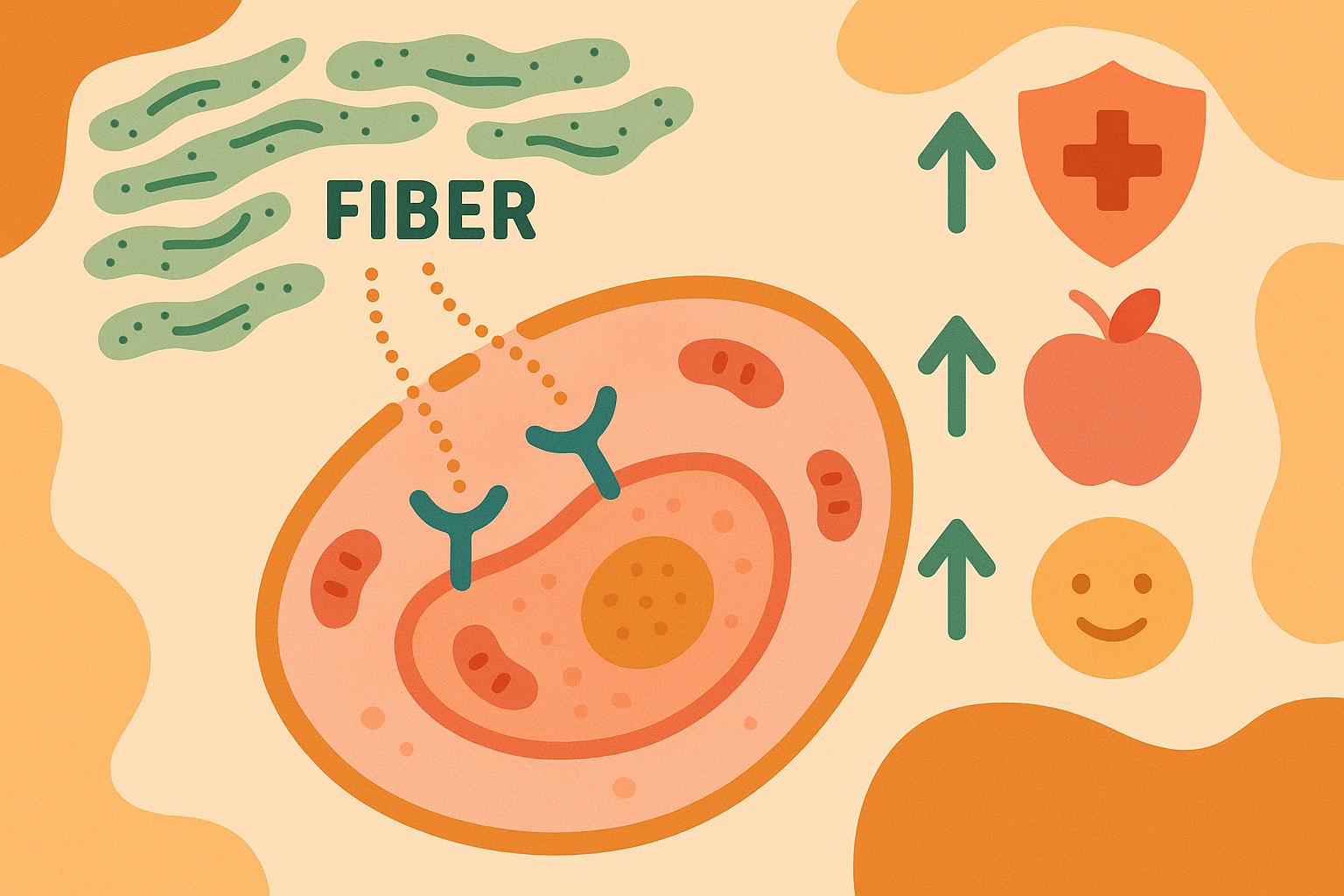
How Fiber Changes Gene Expression
Consistent high-fiber intake creates measurable changes in gene expression that can even be passed to future generations. Your dietary choices become an investment in generational health, influencing which genes get turned on or off in your children and grandchildren.
Changing How Your Genes Work
Fiber breakdown products directly influence genetic expression, potentially reversing genetic predispositions to chronic diseases. These changes can override inherited tendencies toward diabetes, heart disease, and other conditions through consistent fiber intake.
This concept blew my mind when
This concept blew my mind when I first learned about it. We’re talking about literally changing how your genes express themselves through food choices. The implications for long-term health are staggering.
Making Fiber Work in Real Life
Successfully maintaining 25 grams of fiber daily requires understanding the real-world challenges that cause most people to fail. I’ve developed strategies for permanent adoption that address these practical barriers while building sustainable habits you can actually stick with.
Understanding intuitive eating principles helps you develop a healthier relationship with high-fiber foods that doesn’t feel restrictive or overwhelming.
Starting Slow to Avoid Disaster
I’ll never forget my first week trying to hit 25 grams of fiber. I went from eating maybe 10 grams a day to cramming in beans, whole grains, and vegetables like it was my job. The result? Three days of feeling like a balloon about to pop. That’s when I learned the hard way that your gut needs time to adjust.
Building Up Your Fiber-Digesting Enzymes
Your digestive system needs 2-4 weeks to increase production of fiber-digesting enzymes, making gradual increases crucial for comfort and actually sticking with it. I recommend increasing by 5 grams weekly rather than jumping straight to 25 grams and suffering the consequences.
Managing the Bacterial Transition
Sudden fiber increases can cause beneficial bacteria die-offs and temporary digestive chaos. Strategic prebiotics can smooth this transition, preventing the bloating and discomfort that make most people quit within the first week.
Here’s what actually works:
- Week 1: Add 5g fiber daily (focus on easy sources like oats)
- Week 2: Increase to 10g daily (add some beans or lentils)
- Week 3: Reach 15g daily (incorporate more vegetables)
- Week 4: Target 20g daily (add high-fiber fruits)
- Week 5+: Achieve 25g daily (maintain variety and consistency)
- Track how your stomach feels daily
- Increase water intake by 8oz per week
- Note energy levels and mood changes
Let’s talk about the elephant in the room – yes, increasing your fiber might make you gassy at first. It’s not just you, it happens to everyone. Your body adjusts in about 2-3 weeks. In the meantime, drink more water and maybe warn your family.
Setting Up Your Environment for Success
Your kitchen and social environment dramatically influence whether you’ll succeed with fiber goals, requiring intentional changes to make high-fiber choices the easy option. I’ve learned that willpower alone isn’t enough – you need systems that make success inevitable.
Kitchen Setup for Fiber Success
Specific storage, preparation, and serving strategies make high-fiber choices the easiest option while reducing barriers to consistent intake. I keep pre-soaked beans in my freezer and high-fiber snacks at eye level to eliminate decision fatigue.
Maria redesigned her kitchen for fiber success by dedicating her top pantry shelf to high-fiber staples like oats, quinoa, and chia seeds. She batch-prepped mason jars filled with overnight oats each Sunday and kept pre-cut vegetables at eye level in clear containers. This environmental design increased her daily fiber intake from 12g to 28g within a month, with minimal additional effort.
Navigating Social Situations
Dealing with social eating situations while maintaining fiber goals requires simple communication techniques and menu navigation skills. I’ve developed strategies for restaurant dining and social gatherings that don’t make me the “difficult” person at the table.
When dining out, I scan menus for dishes with beans, whole grains, or vegetables as primary components. Most restaurants can accommodate simple modifications like adding extra vegetables or substituting brown rice for white rice.
Tracking What Actually Matters
Tracking the right things allows you to optimize your fiber strategy based on how your individual body responds rather than generic recommendations. This personalized approach ensures your 25-gram target is actually working for your unique situation.
Simple Transit Time Testing
Basic techniques for measuring how quickly food moves through your system allow you to adjust fiber types and timing for optimal function. I use the corn kernel test to track transit time and adjust my fiber distribution accordingly.
Connecting Fiber to How You Feel
Simple approaches for connecting fiber intake patterns with energy, mood, sleep quality, and other wellness indicators help personalize your approach. I track these connections in a basic journal to identify which fiber sources work best for my individual needs.
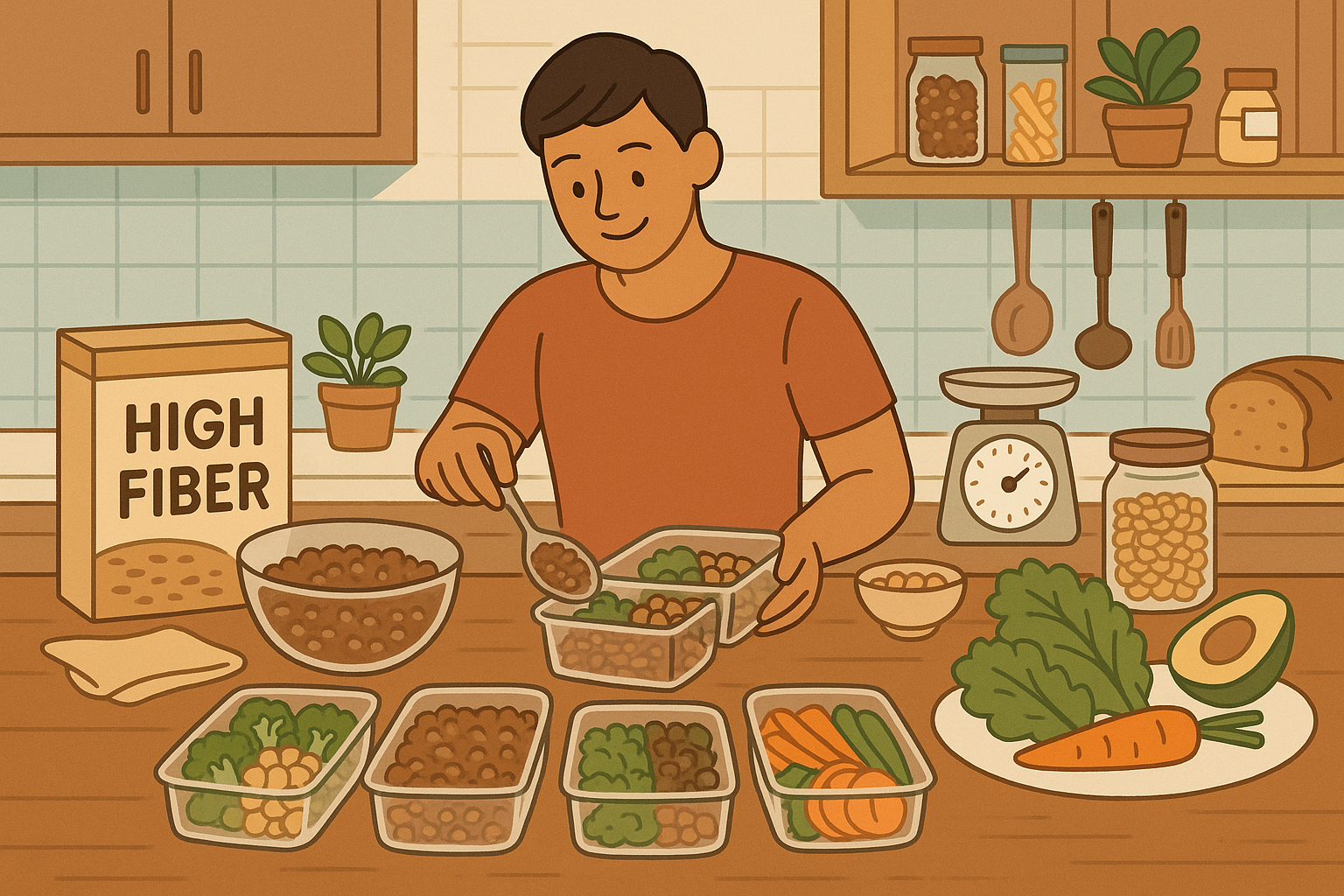
The Best High-Fiber Foods and When to Eat Them
Beyond knowing which foods contain fiber, successful meal planning requires understanding how different high-fiber foods work within meals and across the day. This knowledge optimizes absorption, minimizes digestive distress, and maximizes nutritional benefits that most people completely miss.
The High-Fiber Food Champions
Not all fiber-rich foods are created equal – some provide way more bang for your buck in terms of nutrient density, digestive tolerance, and beneficial bacterial feeding patterns. Understanding this hierarchy prevents meal planning failures and maximizes your 25-gram investment.
Fiber Density Champions vs. Volume Fillers
Want to know which foods pack the most fiber punch? Here are my go-to favorites:
Fiber Champions (5+ grams per serving):
- Black beans: About 8 grams per half cup (and they’re cheap!)
- Raspberries: 8 grams per cup (expensive but worth it as a treat)
- Artichokes: 10 grams each (sounds fancy but you can get frozen ones)
- Chia seeds: 5 grams per tablespoon (sprinkle on literally anything)
- Quinoa: 5 grams per cup cooked
- Lentils: 8 grams per half cup
Volume Fillers (1-3 grams per serving):
- Apples: 3.6 grams medium (great for snacks)
- Bananas: 3.1 grams medium (perfect pre-workout)
- Carrots: 3.6 grams per cup (cheap and versatile)
- Broccoli: 2.3 grams per cup (kids might disagree)
The American Heart Association Eating Plan suggests eating a variety of food fiber sources, with total dietary fiber intake should be 25 to 30 grams a day from food, not supplements, emphasizing the importance of whole food sources over processed alternatives.
Foods That Do Double Duty
The best high-fiber food options simultaneously provide vitamins and minerals that enhance fiber’s beneficial effects, creating multiplicative rather than just additive health benefits. Beans provide fiber plus folate and magnesium, while berries offer fiber with antioxidants that protect the gut lining.
Smart Fiber Timing Throughout the Day
Spreading your 25 grams across meals requires understanding how different fiber types affect digestion speed, satiety duration, and nutrient absorption windows. Poor timing can actually reduce fiber’s benefits or cause uncomfortable digestive issues.
The 5-10-10 Approach That Actually Works
I used to try cramming all my fiber into one meal and felt miserable. Now I spread it out – consuming 5 grams at breakfast, 10 at lunch, and 10 at dinner. This distribution prevents the afternoon energy crash that derails so many people’s healthy eating plans and is way easier on your stomach. You won’t feel like you need to unbutton your pants after eating.
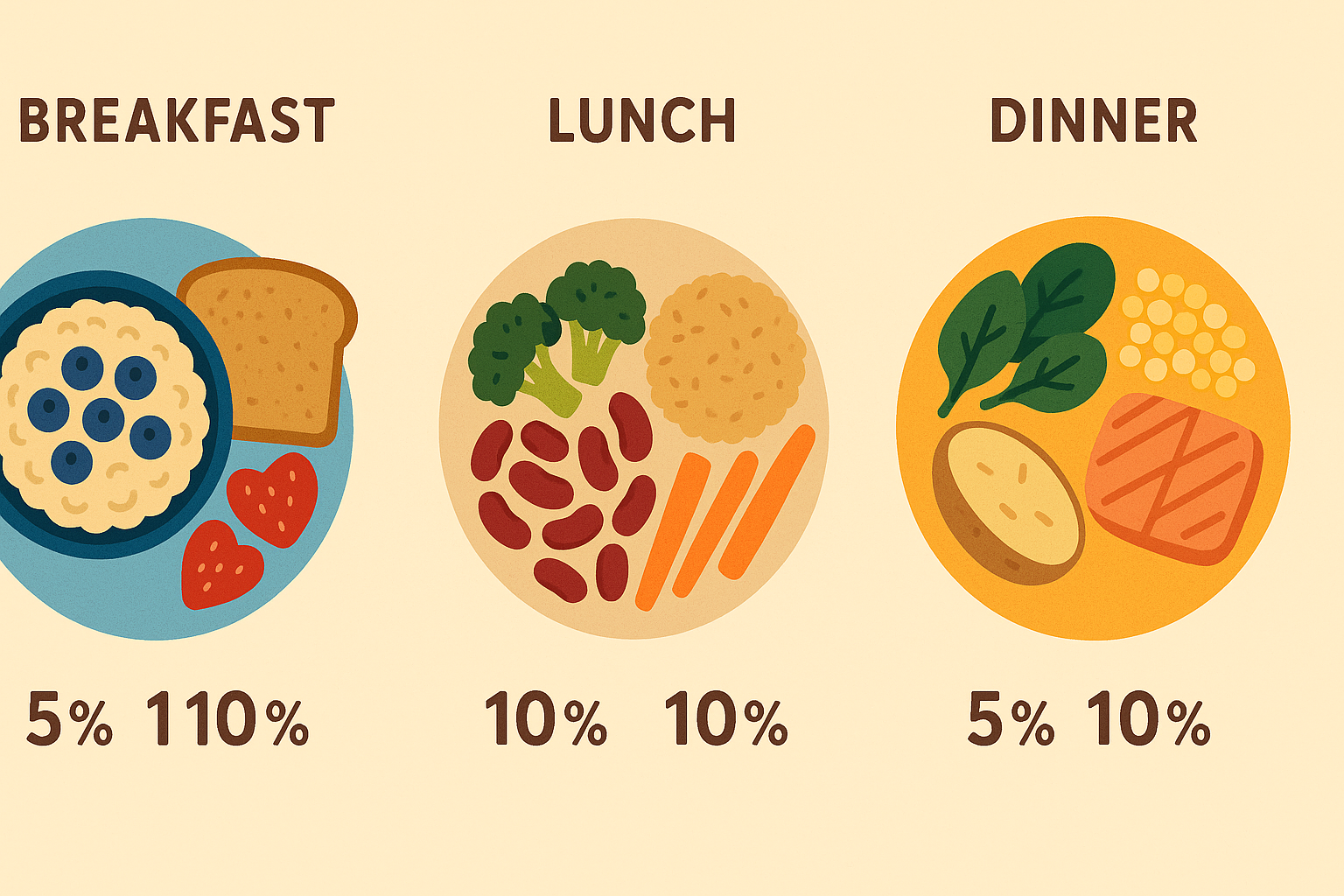
Fiber and Exercise Timing
Specific fiber types can enhance exercise performance when consumed beforehand, while others support recovery when eaten afterward. I avoid high-fiber meals within 2 hours of intense workouts but load up on fiber post-exercise to support muscle recovery and energy replenishment.
Why Evening Fiber Loading Works
Consuming higher fiber amounts in the evening supports overnight detoxification processes and morning elimination patterns while reducing late-night cravings. This strategy also improves sleep quality by stabilizing blood sugar throughout the night.
High-Fiber Food Combinations That Actually Taste Good
Pairing specific high-fiber foods creates effects that enhance nutrient absorption, improve taste, and provide complementary health benefits beyond what each food offers individually. These combinations make reaching 25 grams daily both easier and more enjoyable.
For comprehensive nutrition optimization, learning Dr. Mark Hyman’s 5 rules for a truly healthy breakfast provides the perfect foundation for incorporating high-fiber foods into your morning routine.
Bean and Grain Power Couples
Combining beans with whole grains provides complete proteins and creates fiber combinations that feed different beneficial bacterial strains simultaneously. I pair black beans with brown rice or lentils with quinoa for maximum gut bacteria diversity support.
Tom, a CrossFit athlete, successfully hit his 38-gram daily fiber target by mastering these combinations. His go-to lunch became a quinoa bowl (2.5g fiber) with ½ cup black beans (7.5g fiber), roasted vegetables (3g fiber), and a tablespoon of hemp seeds (1g fiber), totaling 14g fiber in a single satisfying meal that supported his training recovery.
Fruit and Vegetable Fiber Teams
Mixing soluble fruit fibers with insoluble vegetable fibers in single meals creates optimal gel formation and sustained satiety while balancing natural sugar absorption. Apple slices with raw almonds or berries mixed into salads are perfect examples of this strategic pairing approach.
Research shows that 1 cup fresh raspberries (8 grams) and ½ cup cooked black beans (7.5 grams) represent some of the most fiber-dense whole food options available.
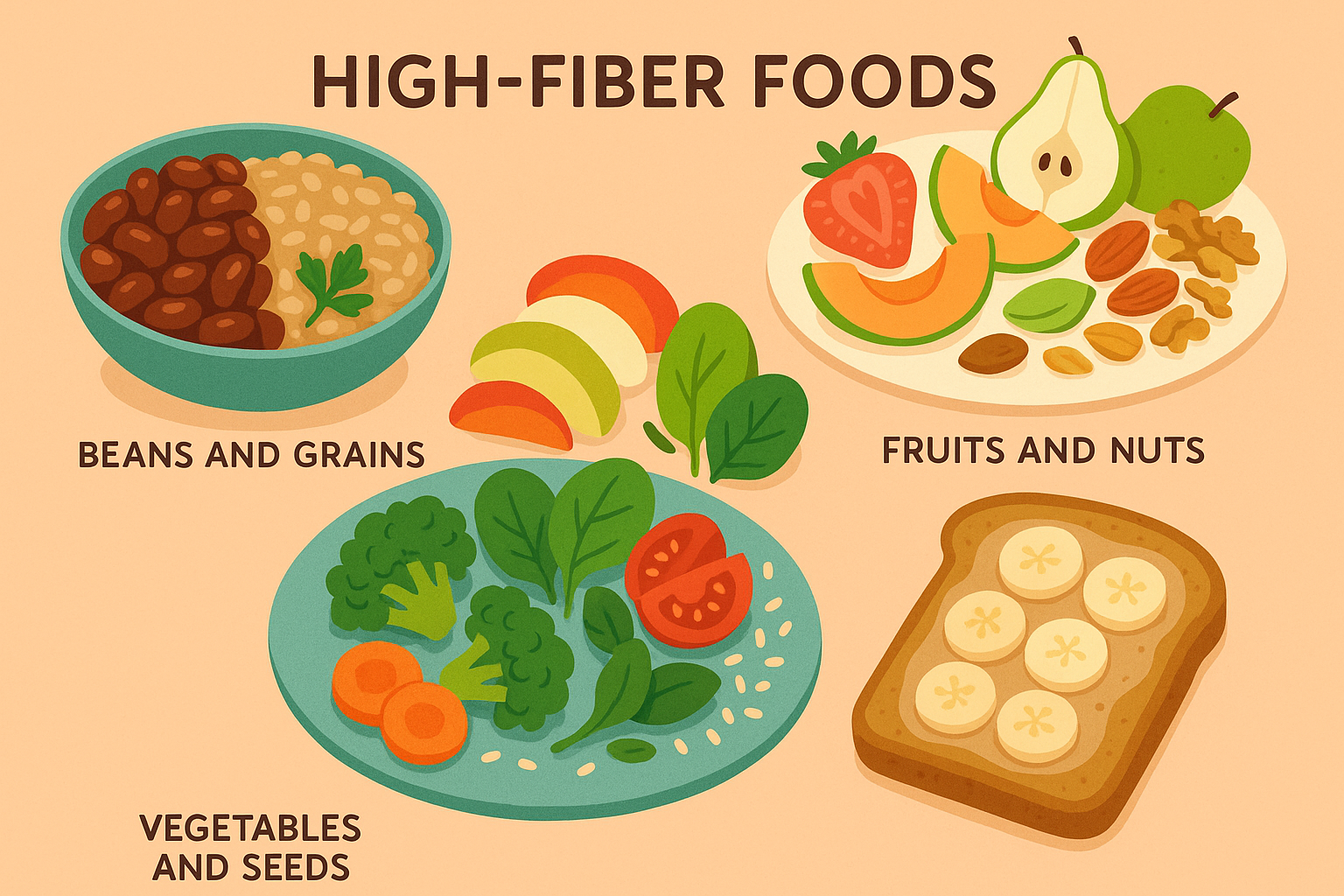
I’m not going to give you some complicated meal plan you’ll never follow. Instead, here’s what works: Pick 3-4 high-fiber foods you actually like eating. Keep them stocked in your kitchen. Add one to each meal. That’s it. You don’t need to overthink this.
Simple High-Fiber Meal Template:
Breakfast (Target: 5-8g fiber)
My go-to high-fiber breakfast? Oatmeal with sliced banana and a handful of berries. Gets me about 8 grams of fiber and actually tastes good.
- Base: Oats, whole grain cereal, or sprouted bread
- Fiber booster: Chia seeds, ground flaxseed, or berries
- Protein: Greek yogurt, nut butter, or eggs
Lunch (Target: 8-12g fiber)
For lunch, I’ll throw some black beans into whatever salad I’m having – instant fiber boost without thinking too hard about it.
- Grain/starch: Quinoa, brown rice, or sweet potato
- Legume: Beans, lentils, or chickpeas
- Vegetables: Mixed greens, roasted vegetables
- Fat source: Avocado, nuts, or seeds
Dinner (Target: 8-12g fiber)
- Protein: Fish, poultry, or tofu
- Complex carb: Whole grains or starchy vegetables
- Fiber-rich vegetables: Brussels sprouts, broccoli, or artichokes
Snacks (Target: 2-5g fiber each)
- Apple with almond butter
- Hummus with carrots
- Trail mix with dried fruit
Grocery shopping for fiber doesn’t have to be complicated. I stick to the outer edges of the store – fruits, vegetables, and the bulk bins for beans and grains. Frozen vegetables count just as much as fresh ones (and they won’t guilt-trip you from the fridge when they go bad).
For those looking to optimize their fiber intake with high-quality, bioavailable supplements, Organic Authority offers carefully vetted fiber products that work synergistically with whole food sources. Their rigorous evaluation process ensures you’re getting supplements that actually enhance rather than replace your whole food fiber strategy.
Understanding the broader context of why dietary fiber is the real macronutrient you need to watch helps prioritize fiber-rich foods over other less impactful dietary changes.
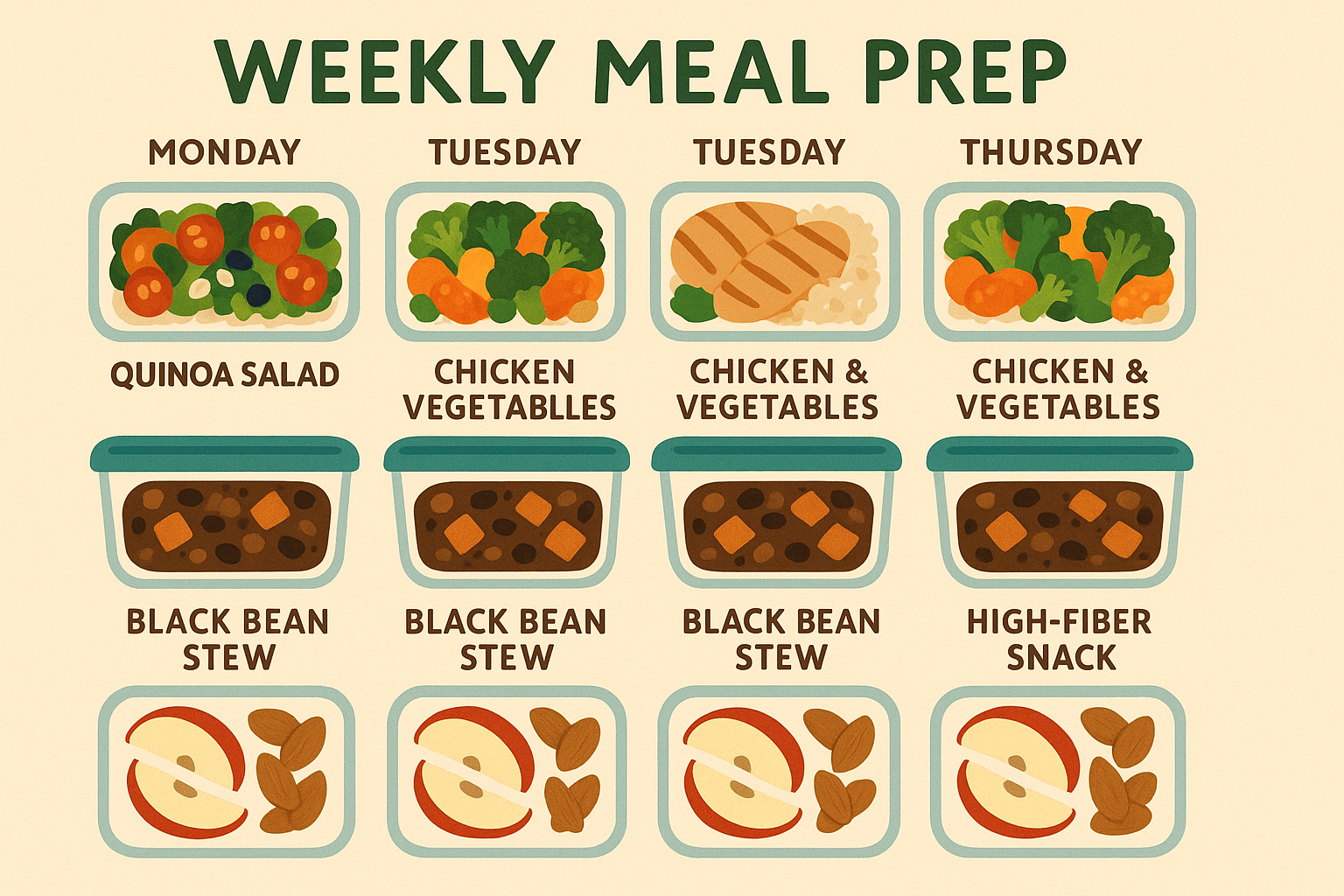
Weekly Fiber Success Checklist:
- Plan three 25g+ fiber days this week
- Prep high-fiber snacks (apples, nuts, hummus)
- Batch cook legumes for easy meal additions
- Stock fiber-dense pantry staples
- Track daily fiber intake using an app or journal
- Schedule grocery shopping for fresh produce
- Prepare overnight oats or chia puddings
- Set reminders for adequate water intake
If you’re feeling bloated: slow down and add fiber more gradually. If you’re not seeing benefits: make sure you’re drinking enough water. If you hate the foods you’re trying: find different ones. There are dozens of high-fiber foods – you don’t have to force yourself to eat the ones that make you miserable.
<img src="https://staging-swiftbrief-featured-images.s3.eu-central-1.amazonaws.com/zrmzt 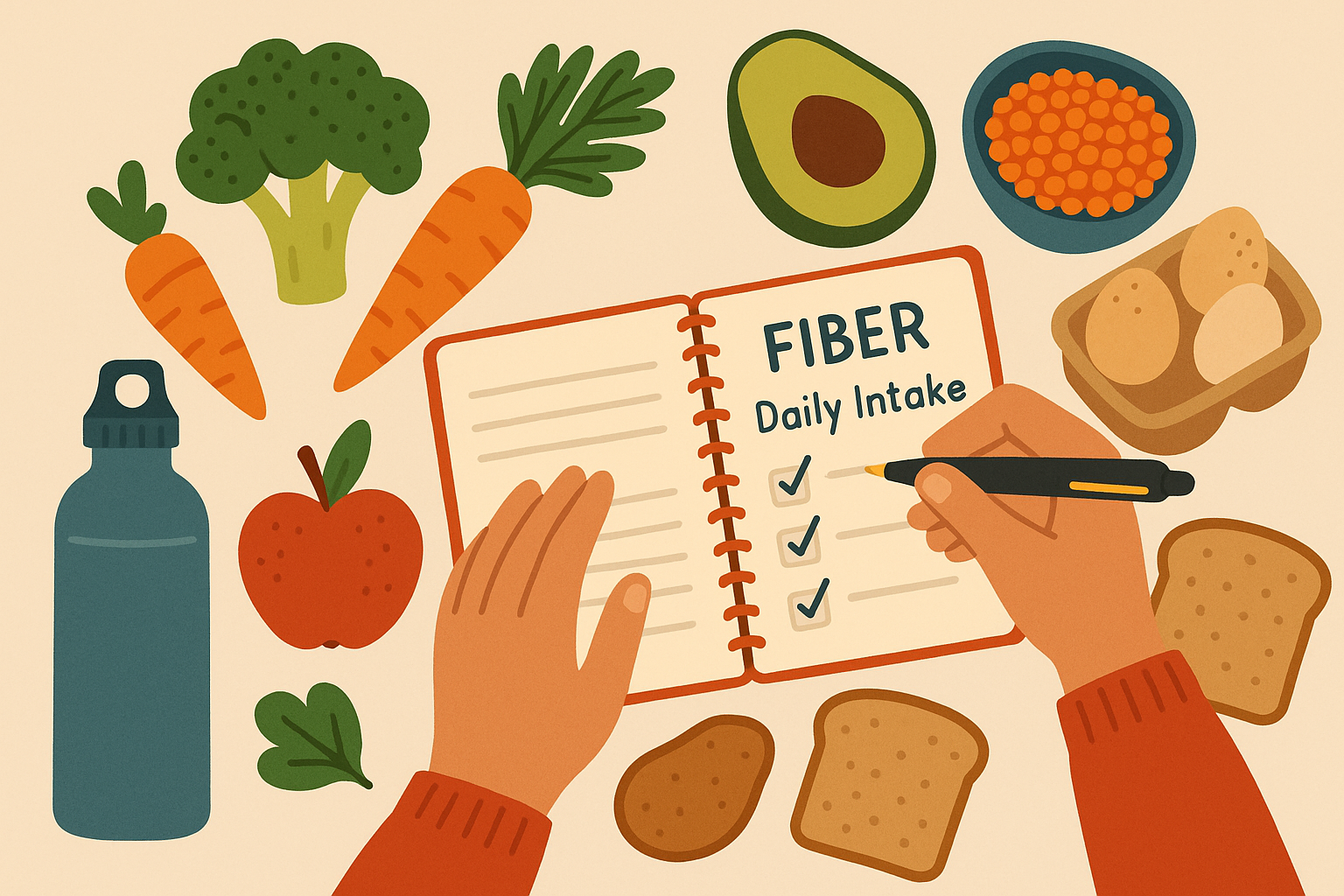
Final Thoughts
Look, I’m not going to promise that eating more fiber will transform your life overnight. But after doing this for a few years, I can tell you it’s one of those small changes that adds up to feeling noticeably better. And honestly, that’s worth the effort of remembering to buy some extra vegetables at the grocery store.
The journey toward getting enough fiber isn’t always comfortable (trust me, I’ve made the mistakes of increasing too quickly), but the long-term benefits go way beyond improved regularity. You know that 3 PM energy crash that has you reaching for coffee or something sweet? Getting enough fiber can actually prevent that. Or those nights when you’re wide awake thinking about work? The right fiber timing can help with that too.
For those ready to take their digestive health to the next level, exploring whether drinking vinegars are the next big thing for gut health provides additional tools that complement a high-fiber nutrition strategy.
What I love most about this approach is how it works with your body’s natural systems while giving you practical steps you can actually follow. Your gut bacteria are incredibly smart, and they deserve more than random fiber consumption – they deserve a strategic partnership that recognizes how timing, type, and individual responses all matter.
Some weeks you’ll nail your fiber goals. Other weeks you’ll survive on crackers and coffee because life happened. Both are normal. The people who succeed long-term are the ones who get back on track without beating themselves up about it.
Remember, this isn’t about perfection from day one. Start with adding 5 grams this week, drink more water, and don’t try to overhaul your entire diet overnight. Your gut will thank you for taking it slow. Experiment with the timing strategies that feel doable for your lifestyle, and pay attention to how your body responds. Your optimal fiber strategy will be uniquely yours, built through consistent experimentation and careful observation of what works best for your individual situation and daily routine.
Within about a week of eating more fiber consistently, you’ll probably notice you’re not as hungry between meals. Within a month, your energy will be more stable throughout the day. These aren’t life-changing revelations, but they’re the kind of small improvements that make daily life better. Trust me, your future self will thank you for making these small changes now.

